GH-227C环保清洗剂物质安全资料表(第一版本)
- 格式:doc
- 大小:53.00 KB
- 文档页数:6
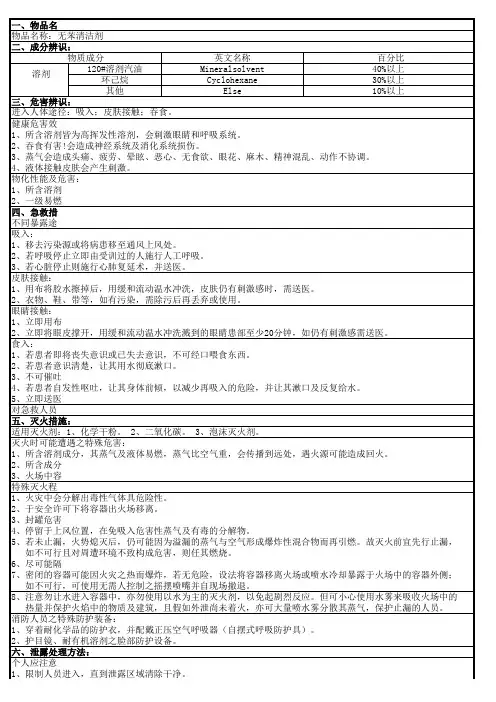
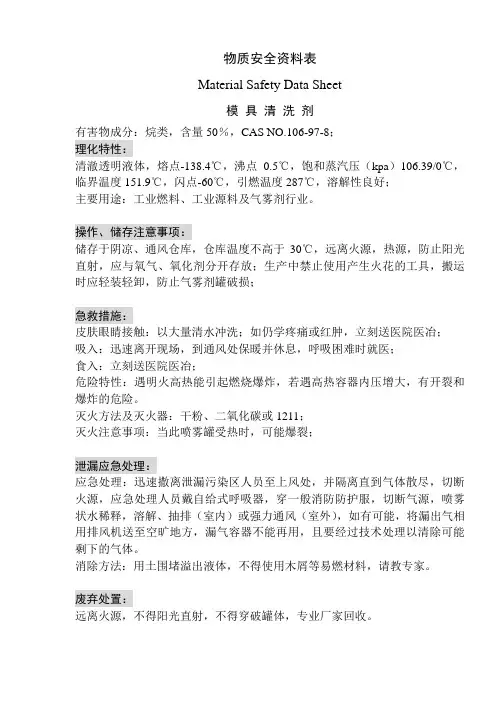
物质安全资料表
Material Safety Data Sheet
模具清洗剂
有害物成分:烷类,含量50%,CAS NO.106-97-8;
理化特性:
清澈透明液体,熔点-138.4℃,沸点0.5℃,饱和蒸汽压(kpa)106.39/0℃,临界温度151.9℃,闪点-60℃,引燃温度287℃,溶解性良好;
主要用途:工业燃料、工业源料及气雾剂行业。
操作、储存注意事项:
储存于阴凉、通风仓库,仓库温度不高于30℃,远离火源,热源,防止阳光直射,应与氧气、氧化剂分开存放;生产中禁止使用产生火花的工具,搬运时应轻装轻卸,防止气雾剂罐破损;
急救措施:
皮肤眼睛接触:以大量清水冲洗;如仍学疼痛或红肿,立刻送医院医冶;
吸入:迅速离开现场,到通风处保暖并休息,呼吸困难时就医;
食入:立刻送医院医冶;
危险特性:遇明火高热能引起燃烧爆炸,若遇高热容器内压增大,有开裂和爆炸的危险。
灭火方法及灭火器:干粉、二氧化碳或1211;
灭火注意事项:当此喷雾罐受热时,可能爆裂;
泄漏应急处理:
应急处理:迅速撒离泄漏污染区人员至上风处,并隔离直到气体散尽,切断火源,应急处理人员戴自给式呼吸器,穿一般消防防护服,切断气源,喷雾状水稀释,溶解、抽排(室内)或强力通风(室外),如有可能,将漏出气相用排风机送至空旷地方,漏气容器不能再用,且要经过技术处理以清除可能剩下的气体。
消除方法:用土围堵溢出液体,不得使用木屑等易燃材料,请教专家。
废弃处置:
远离火源,不得阳光直射,不得穿破罐体,专业厂家回收。
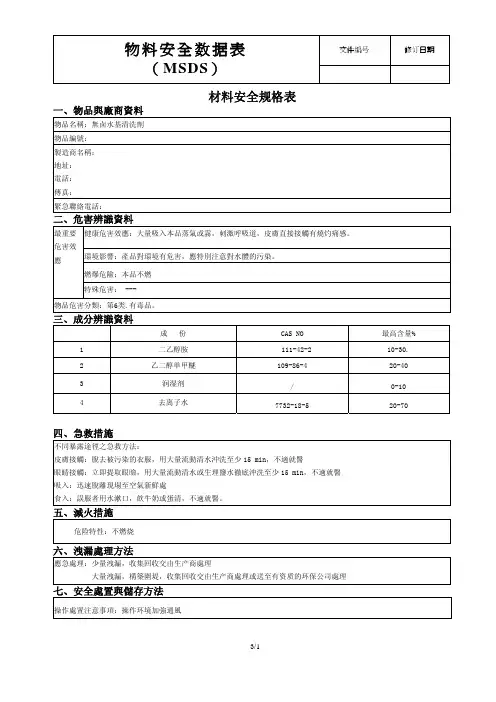
材料安全规格表 一、物品與廠商資料物品名稱:無卤水基清洗劑物品編號:製造商名稱:地址:電話:傳真:緊急聯絡電話:二、危害辨識資料最重要危害效應 健康危害效應:大量吸入本品蒸氣或霧,刺激呼吸道,皮膚直接接觸有燒灼痛感。
環境影響:產品對環境有危害,應特別注意對水體的污染。
燃爆危險:本品不燃特殊危害: ---物品危害分類:第6类.有毒品。
三、成分辨識資料成 份 CAS NO 最高含量%1 二乙醇胺 111-42-210-30.2 乙二醇单甲醚109-86-420-403 润湿剂 / 0-104 去离子水 7732-18-5 20-70四、急救措施不同暴露途徑之急救方法:皮膚接觸:脫去被污染的衣服,用大量流動清水沖洗至少15 min,不適就醫眼睛接觸:立即提取眼瞼,用大量流動清水或生理鹽水徹底沖洗至少15 min,不適就醫吸入:迅速脫離現場至空氣新鮮處食入:誤服者用水漱口,飲牛奶或蛋清,不適就醫。
五、滅火措施危险特性:不燃烧六、洩漏處理方法應急處理:少量洩漏,收集回收交由生产商處理大量洩漏,構築圍堤,收集回收交由生产商處理或送至有资质的环保公司處理七、安全處置與儲存方法操作處置注意事項:操作环境加強通風儲存注意事項:儲存於陰涼、通風倉庫內,防止陽光直射,保持容器密封,應與氧化劑、酸類分開存放 八、接触控制/个体防护最高允許濃度:中國未制定工程控制:對作業環境保持良好通風。
眼睛防護:戴化學安全防護眼鏡手防護:戴胶手套其他防護:工作現場嚴禁進食和飲水九、理化特性外觀與性狀:蓝色液体 熔点:未测得沸点℃:105±5℃ 闪点:无闪点密度,g/cm3(20℃):1.00±0.1 PH值:11±0.5溶解性:易溶于水十、穩定性和反應活性稳定性:稳定禁配物:強氧化劑、酸、銅、鋅避免接觸的條件:……聚合危险:不聚合分解产物:CO、CO2、NO十一、毒理学资料急性毒性:LD50 1950mg/kg(大鼠经口)1350mg/kg(兔经皮)慢性毒性:大鼠經口180mg/kg 90天某些器官有損害十二、生態資料生態毒性:無資料生物降解性:可降解生物富集成生物積累性:無十三、廢棄處置方法廢棄物性質:一般工業廢物廢棄處置方法:由生产商處理或送至有资质的环保公司處理废弃注意事项:无十四、運送資料包裝方法:塑膠桶密封包裝運輸注意事項:搬運輕拿輕放,防止包裝破損十五、法規資料下列法规法律对化学品的安全使用、储存、运输、装卸、分类和标志等方面均作了相应的规定:GBI 16483-2008《化学品安全技术说明》GB205PZ-2006《化学品分类,警示标签和警示性说明安全规范》GB 15258《化学品安全标签编写规定》《危险化学品安全管理条例》(2011年2月16日国务院第144次常务会议通过);《安全生产许可证条例》(-2004年1月7日国务院第34次常务会议通过)。
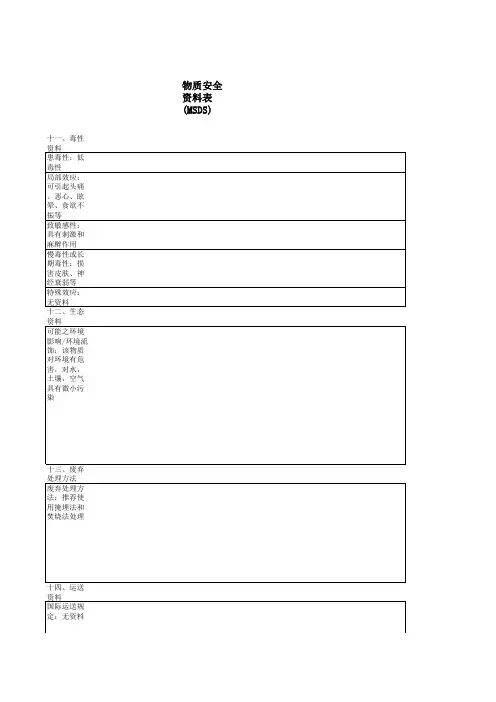
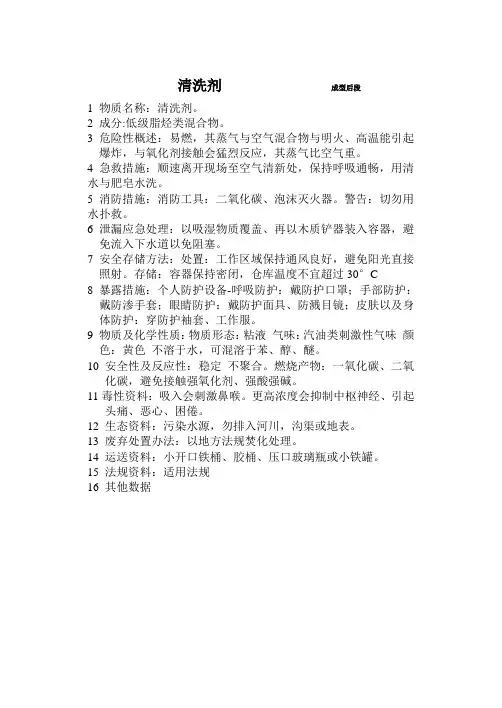
清洗剂成型后段
1 物质名称:清洗剂。
2 成分:低级脂烃类混合物。
3 危险性概述:易燃,其蒸气与空气混合物与明火、高温能引起
爆炸,与氧化剂接触会猛烈反应,其蒸气比空气重。
4 急救措施:顺速离开现场至空气清新处,保持呼吸通畅,用清水与肥皂水洗。
5 消防措施:消防工具:二氧化碳、泡沫灭火器。
警告:切勿用水扑救。
6 泄漏应急处理:以吸湿物质覆盖、再以木质铲器装入容器,避
免流入下水道以免阻塞。
7 安全存储方法:处置:工作区域保持通风良好,避免阳光直接
照射。
存储:容器保持密闭,仓库温度不宜超过30°C
8 暴露措施:个人防护设备-呼吸防护:戴防护口罩;手部防护:
戴防渗手套;眼睛防护:戴防护面具、防溅目镜;皮肤以及身体防护:穿防护袖套、工作服。
9 物质及化学性质:物质形态:粘液气味:汽油类刺激性气味颜
色:黄色不溶于水,可混溶于苯、醇、醚。
10安全性及反应性:稳定不聚合。
燃烧产物:一氧化碳、二氧化碳,避免接触强氧化剂、强酸强碱。
11毒性资料:吸入会刺激鼻喉。
更高浓度会抑制中枢神经、引起头痛、恶心、困倦。
12 生态资料:污染水源,勿排入河川,沟渠或地表。
13 废弃处置办法:以地方法规焚化处理。
14 运送资料:小开口铁桶、胶桶、压口玻璃瓶或小铁罐。
15 法规资料:适用法规
16 其他数据。
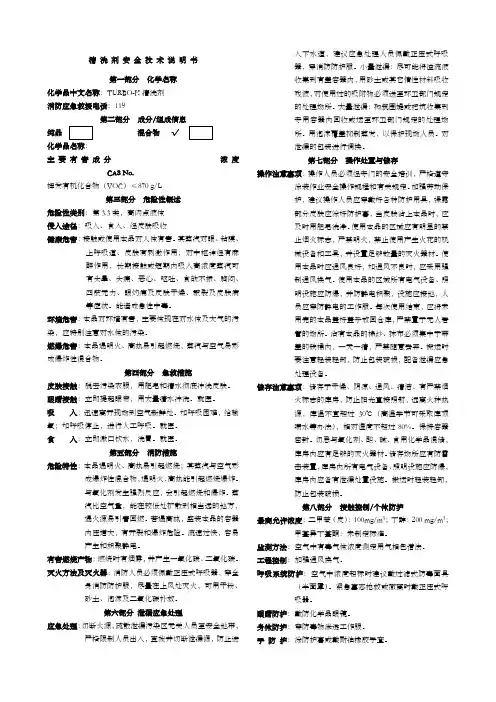
清 洗 剂 安 全 技 术 说 明 书第一部分 化学名称化学品中文名称:TURBO-K 清洗剂 消防应急救援电话:119第二部分 成分/组成信息纯品混合物 √主要有害成分 浓度 CAS No.挥发有机化合物(VOC )≤870 g/L第三部分 危险性概述危险性类别:第3.3类,高闪点液体 侵入途径:吸入、食入、经皮肤吸收健康危害:接触或使用本品对人体有害。
其蒸汽对眼、粘膜、上呼吸道、皮肤有刺激作用,对中枢神经有麻醉作用,长期接触或短期内吸入高浓度蒸汽可有头晕、头痛、恶心、呕吐、食欲不振、胸闷、四肢无力、眼灼痛及皮肤干燥、皲裂及皮肤病等症状。
能造成急性中毒。
环境危害:本品对环境有害,主要体现在对水体及大气的污染,应特别注意对水体的污染。
燃爆危害:本品遇明火、高热易引起燃烧,蒸汽与空气易形成爆炸性混合物。
第四部分 急救措施皮肤接触:脱去污染衣服,用肥皂和清水彻底冲洗皮肤。
眼睛接触:立即提起眼帘,用大量清水冲洗。
就医。
吸 入:迅速离开现场到空气新鲜处。
如呼吸困难,给输氧;如呼吸停止,进行人工呼吸。
就医。
食 入:立即漱口饮水,洗胃。
就医。
第五部分 消防措施危险特性:本品遇明火、高热易引起燃烧;其蒸汽与空气形成爆炸性混合物,遇明火、高热能引起燃烧爆炸。
与氧化剂发生强烈反应,会引起燃烧和爆炸。
蒸汽比空气重,能在较低处扩散到相当远的地方,遇火源易引着回燃。
若遇高热,盛装本品的容器内压增大,有开裂和爆炸危险。
流速过快,容易产生和积聚静电。
有害燃烧产物:燃烧时有烟雾,并产生一氧化碳、二氧化碳。
灭火方法及灭火器:消防人员必须佩戴正压式呼吸器,穿全身消防防护服,尽量在上风处灭火,可用干粉、砂土、泡沫及二氧化碳扑救。
第六部分 泄漏应急处理应急处理:切断火源,疏散泄漏污染区无关人员至安全地带,严格限制人员出入,查找并切断泄漏源,防止进入下水道,建议应急处理人员佩戴正压式呼吸器,穿消防防护服。
小量泄漏:尽可能将溢流液收集到有盖容器内,用砂土或其它惰性材料吸收残液,对使用过的吸附物必须送至环卫部门规定的处理场所。
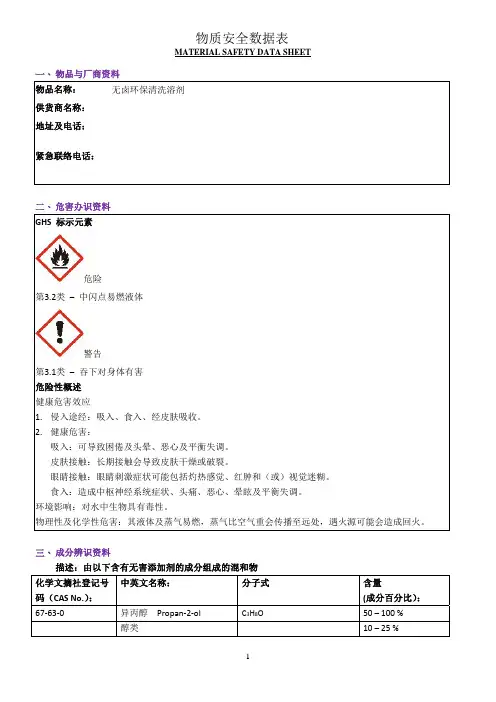
一、 物品与厂商资料物品名称: 无卤环保清洗溶剂供货商名称:地址及电话:紧急联络电话:二、 危害办识资料GHS 标示元素危险第3.2类 – 中闪点易燃液体警告第3.1类 – 吞下对身体有害危险性概述健康危害效应1.侵入途经:吸入、食入、经皮肤吸收。
2.健康危害:吸入:可导致困倦及头晕、恶心及平衡失调。
皮肤接触:长期接触会导致皮肤干燥或破裂。
眼睛接触:眼睛刺激症状可能包括灼热感觉、红肿和(或)视觉迷糊。
食入:造成中枢神经系统症状、头痛、恶心、晕眩及平衡失调。
环境影响:对水中生物具有毒性。
物理性及化学性危害:其液体及蒸气易燃,蒸气比空气重会传播至远处,遇火源可能会造成回火。
三、 成分辨识资料描述:由以下含有无害添加剂的成分组成的混和物化学文摘社登记号码(CAS No.): 中英文名称: 分子式 含量(成分百分比):67‐63‐0 异丙醇 Propan‐2‐ol C3H8O 50 – 100 % 醇类 10 – 25 %碳氢溶剂 2.5– 10 %四、 急救措施不同暴露途径之急救方法:吸 入: 将受害者迁移到空气清新的地方。
如受害者没有在短时间内复原,应将其送到最接近肇事地点的医疗设施接受进一步的医疗。
皮肤接触: 脱去污染衣物。
用水冲洗暴露的部位,并用肥皂(如有)进行清洗。
眼睛接触: 立即撑开眼睛用大量水冲洗眼睛最少15分钟。
将受害者送到最接近的医疗设施接受医疗。
食 入: 如意外吞服本品,切勿诱导呕吐:将受害者送到最接近的医疗设施接受进一步医疗。
如呕吐自动发生,应确保受害者的头部位置低于腰部以防发生误吸入呼吸道。
五、 灭火措施适用灭火剂:使用二氧化碳,灭火粉,干粉,砂土或者抗溶性泡沫灭火。
用喷洒水来保持邻接容器冷却,但无法灭火。
灭火时可能遭遇之特殊危害:如燃烧不完全有可能释放出一氧化碳。
蒸气比空气重,因此会沿地面扩散, 从而发生远距点火。
消防人员之特殊防护装备:穿戴全身化学防护衣,防火外套,呼吸器。

GGH清洗剂物质资料安全表(MSDS)发布时间2011-11-17GGH清洗剂物质资料安全表(MSDS)一、生产厂商及标识制造商名称:天津天化科威水处理技术有限公司电话/传真:3中文名:GGH清洗剂型号:TH-001危险性类别:二、主要组成与性状:主要成分:聚羧酸盐、渗透剂、膨化剂等外观与性状:淡黄色透明液体。
主要用途:主要用作火力发电厂湿法脱硫装置GGH搪瓷加热元件表面硫酸盐的常温清洗,同时广泛应用于锅炉、热交换器、管道等硫酸盐的清洗。
三、健康危害:本品呈若碱性,属低毒或无毒,对皮肤有一定的刺激性和腐蚀性,操作人员在进行作业时,应戴上防护用具,避免直接接触皮肤。
一旦溅入眼睛或沾染皮肤,清用清水冲洗即可。
四、急救措施:皮肤接触:用清水冲洗即可。
吸入:超浓度吸入后,迅速转移至空气新鲜处换气,片刻即好。
眼睛接触:清洗液溅入眼睛时,用清水冲洗15min以上,严重者再就医治疗。
误食:饮足量温水或生理盐水并催吐,再就医治疗。
五、爆炸特性与消防:燃烧性:不燃闪点(℃):无引燃温度(℃):无最小点火能(MJ):无六、泄漏应急处理:小量泄漏:用清水冲洗或用砂土或其它吸附材料吸收。
大量泄漏:构筑围堤或挖坑收容,再用普通泵转移至容器内。
七、储运注意事项:本品不燃、不爆、,储存于阴凉,通风仓库内。
八、防护措施:检测方法:气相色谱法、分光光度法。
眼睛防护:普通条件下使用无危险,不需特殊防护。
皮肤防护:清洗液与皮肤接触时,用清水洗掉即可。
手防护:作业时戴橡胶手套。
其它:注意个人清洁卫生,避免长期反复接触。
九、理化性质:熔点(℃):-35℃沸点(℃):100℃相对密度:(25℃)~1.225g/cm3溶解性:可与水任意混溶。
十、稳定性和发应活性稳定性:稳定聚合危险:不聚合禁忌物:强还原剂。
十一、毒理学资料:急性毒性:LD50 7600mg/kg(鼠经口腔一次摄入)9400 mg/kg(兔经皮肤经脉注射)270g/kg(换算成人体重时的致死量)刺激性:家兔经眼:5190ug,重度刺激。
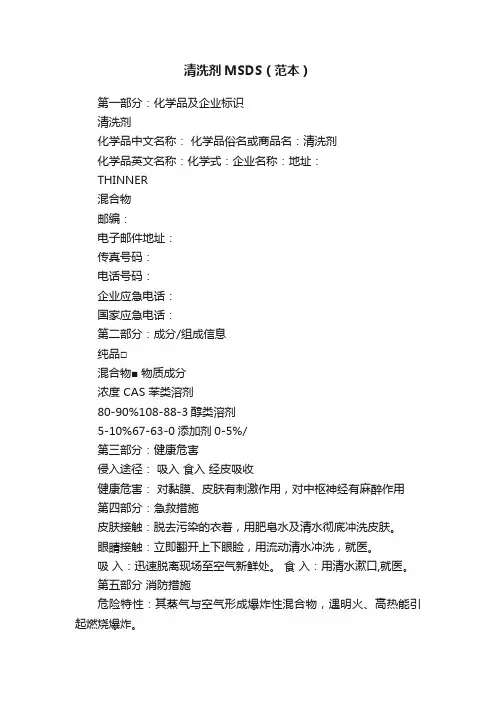
清洗剂MSDS(范本)第一部分:化学品及企业标识清洗剂化学品中文名称:化学品俗名或商品名:清洗剂化学品英文名称:化学式:企业名称:地址:THINNER混合物邮编:电子邮件地址:传真号码:电话号码:企业应急电话:国家应急电话:第二部分:成分/组成信息纯品□混合物■ 物质成分浓度 CAS 苯类溶剂80-90%108-88-3醇类溶剂5-10%67-63-0添加剂0-5%/第三部分:健康危害侵入途径:吸入食入经皮吸收健康危害:对黏膜、皮肤有刺激作用,对中枢神经有麻醉作用第四部分:急救措施皮肤接触:脱去污染的衣着,用肥皂水及清水彻底冲洗皮肤。
眼睛接触:立即翻开上下眼睑,用流动清水冲洗,就医。
吸入:迅速脱离现场至空气新鲜处。
食入:用清水漱口,就医。
第五部分消防措施危险特性:其蒸气与空气形成爆炸性混合物,遇明火、高热能引起燃烧爆炸。
有害燃烧产物:CO CO2灭火方法及灭火剂:可用泡沫、二氧化碳、干粉扑火。
第六部分泄漏应急处理应急处理:切断火源。
尽可能切断泄漏源。
防止进入下水道、排洪沟等限制性空间。
小量泄漏:尽可能将溢漏液收集在密闭容器内,用砂土、活性碳或其它惰性材料吸收残液,大量泄漏:构筑围堤或挖坑收容。
用泡沫覆盖,降低蒸气灾害。
回收或运至废物处理场所处理。
第七部分操作处置与储存操作注意事项:易燃,密闭操作,加强通风。
搬运时要轻装轻卸,防止包装及容器损坏。
储存注意事项:储存在5-30℃的避光、阴凉、通风库房。
远离火种、热源。
容器保持密封,保质期为自生产之日起半年,客户使用时请遵循先入先出的原则。
仓库内照明,通风设施采用防爆型,开关设在仓库外,禁止使用易产生火花的机械设备和工具。
第八部分接触控制/个体防护工程控制:生产过程密切加强通风。
呼吸系统防护:高浓度近距离接触时应该佩戴自吸过滤式防毒面罩(半面罩)。
眼睛防护:戴化学防护眼镜。
身体防护:穿防静电工作服。
手防护:戴橡胶耐油手套。
其他防护:工作现场禁止吸烟、进食和饮水。
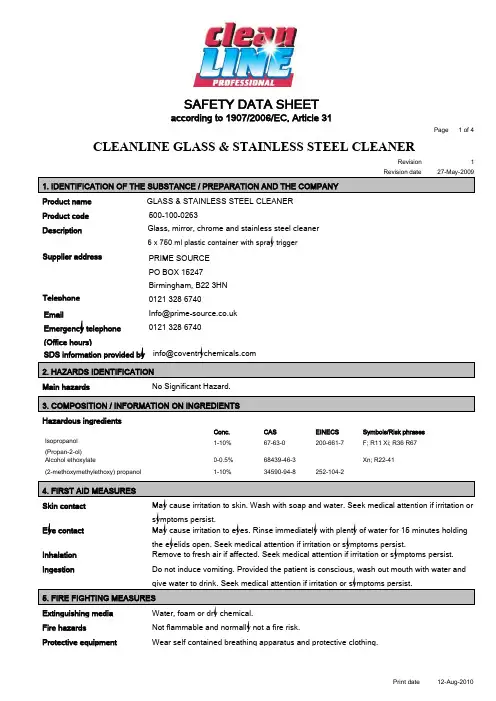
SAFETY DATA SHEETaccording to 1907/2006/EC, Article 31CLEANLINE GLASS & STAINLESS STEEL CLEANER1 of 4Page1RevisionProduct name GLASS & STAINLESS STEEL CLEANER Product code 500-100-0263Description Glass, mirror, chrome and stainless steel cleaner6 x 750 ml plastic container with spray triggerSupplier addressTelephone PRIME SOURCE PO BOX 15247 Birmingham, B22 3HN 0121 328 6740EmailEmergency telephone (Office hours)0121 328 6740SDS information provided by Main hazardsNo Significant Hazard.Hazardous ingredientsConc. CAS Symbols/Risk phrases EINECS Isopropanol (Propan-2-ol) 1-10% 67-63-0 F; R11 Xi; R36 R67 200-661-7Alcohol ethoxylate0-0.5% 68439-46-3 Xn; R22-41(2-methoxymethylethoxy) propanol1-10%34590-94-8252-104-2 Skin contact May cause irritation to skin. Wash with soap and water. Seek medical attention if irritation or symptoms persist.Eye contact May cause irritation to eyes. Rinse immediately with plenty of water for 15 minutes holding the eyelids open. Seek medical attention if irritation or symptoms persist.Inhalation Remove to fresh air if affected. Seek medical attention if irritation or symptoms persist. IngestionDo not induce vomiting. Provided the patient is conscious, wash out mouth with water and Extinguishing media Water, foam or dry chemical.Fire hazards Not flammable and normally not a fire risk.Protective equipmentWear self contained breathing apparatus and protective clothing.Personal precautions Ensure adequate ventilation of the working area.Environmental precautions Prevent further spillage if safe. Do not allow to contaminate watercourses, drains or sewers. Clean up methodsFor small spills: Dilute to waste with large quantities of water, wash into foul sewer only. For large spills: Absorb with inert, absorbent material (sand, earth or granules). Transfer to suitable, labelled containers for disposal. Clean spillage area thoroughly with plenty of water.HandlingEnsure adequate ventilation of the working area. Avoid contact with eyes and skin. Wear appropriate protective equipment (see Section 8). Adopt best Manual Handlingconsiderations when handling, carrying and dispensing.Storage Keep in a cool, dry, well ventilated area. Keep containers tightly closed. Store in correctly labelled containers.Suitable packagingKeep in original packaging.Exposure limitsIsopropanol (Propan-2-ol)WEL 8-hr limit ppm: 400 WEL 15 min limit ppm: 500 WEL 8-hr limit mg/m3: 999 WEL 15 min limit mg/m3: 1250 (2-methoxymethylethoxy) propanolWEL 8-hr limit ppm: 50 WEL 15 min limit ppm: -WEL 8-hr limit mg/m3: 308 WEL 15 min limit mg/m3: -Engineering measures Ensure adequate ventilation of the working area. Respiratory protection Not normally required.Hand protection Rubber or polyvinyl chloride (PVC) gloves. Eye protection In case of splashing, wear: Approved safety glasses. Protective equipment Wear protective clothing.Environmental exposure controls Users should be aware of environmental considerations and their duties under the environmental protection act. Further information may be found on Government websites: /access/index.htm and . Hygiene measuresAlways wash thoroughly after handling chemicals.Description Liquid. Colour Blue. Odour Characteristic. pH 3.2 - 4.2 Flash point 37°CFlammability limits Does not support combustion. Relative density0.98 - 1.01Stability Stable under normal conditions. Conditions to avoid Extremes of temperature. Direct sunlight. Materials to avoid Do not mix with other cleaning chemicals. Hazardous decomposition None when stored and handled correctly.CorrosivityMay cause irritation to skin. May cause irritation to eyes. Large quantities swallowed may cause gastro-intestino irritation, possibly vomiting.Repeated or prolonged Prolonged or repeated contact may cause defatting and subsequent irritation.Degradability Readily biodegradable.Further informationThe surfactant(s) contained in this preparation complies (comply) with the biodegradability criteria as laid down in Regulation (EC) No.648/2004 on detergents.Data to support this assertion are held at the disposal of the competent authorities of the Member States and will be made available to them at their direct request or at the request of a detergent General information Dispose of in compliance with all local and national regulations.Disposal methodsWhere practical, waste or surplus material should be recovered and recycled.Dispose of according to national and local authority regulations via an appropriately licensedwaste contractor.Disposal of packagingPackaging is recyclable and, where practical, containers and packaging should be recycled Further informationThe product is not classified as dangerous for carriage.Risk phrases No Significant Hazard.Safety phrasesP14 - Safety data sheet available for professional user on request. S2 - Keep out of the reach of children.S26 - In case of contact with eyes, rinse immediately with plenty of water and seek medical advice.Text of risk phrases in Section 3R11 - Highly flammable.R22 - Harmful if swallowed.R36 - Irritating to eyes.R41 - Risk of serious damage to eyes.General information PLEASE ENSURE THIS SAFETY DATA SHEET IS PASSED TO THE APPROPRIATEPERSONS IN YOUR COMPANY, WHO ARE CAPABLE OF ACTING ON THEINFORMATION.This Data Sheet was prepared in accordance with directive 91/155/EEC and the Chemicals(Hazard Information and Packaging for Supply) Regulations.Occupational exposure standards were taken from the current edition of EH40 (UK HSE).The information given is based on our knowledge of this product at the time of publication.The information this sheet contains does not constitute on its own the users ownassessment of workplace risk as required by other health and safety legislation eg. HSWACT COSHH, MHSW Regulations or other. The user’s attention is drawn to the possiblerisks incurred by using the product for any other purpose than that for which it was intended.Further information The information supplied in this Safety Data Sheet is designed only as guidance for the safeuse, storage and handling of the product. This information is correct to the best of ourknowledge and belief at the date of publication however no guarantee is made to itsaccuracy. This information relates only to the specific material designated and may not bevalid for such material used in combination with any other materials or in any other process. Revision This document differs from the previous version in the following areas:15 - risk phrases.。
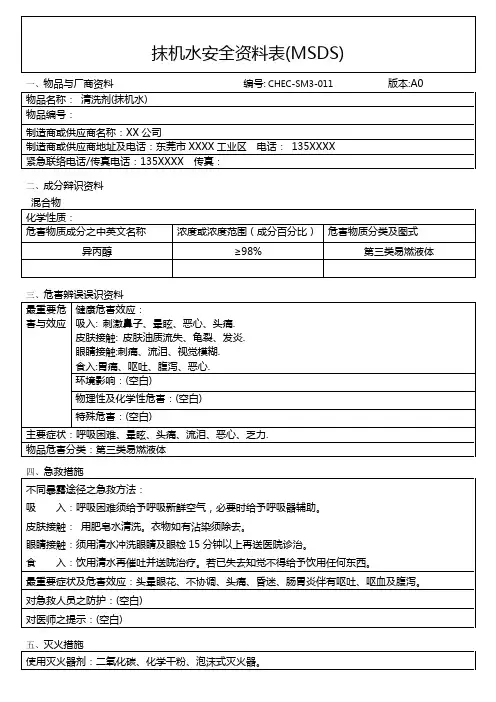
化学品安全技术说明书第一部分化学品及企业标识化学品中文名称:环保清洗剂化学品俗名或商品名:Fisher 2000-28化学品英文名称:Environment protection cleaning agent Fisher 2000-28企业名称:飞世尔(香港)科技股份有限公司地址:香港木星街3号泽盈中心深圳公司地址:深圳市宝安区龙华镇和平西路鹏华工业园10栋邮编:518109电子邮件地址:fisher@传真号码:86755-29675850企业应急电话:86755-29675975技术说明书编码:F-07-MC-28生效日期:2000.05.01第二部分成份及组成信息纯品:混合物:√化学品名称:未公开有害物成份浓度CAS NO无无无第三部分危险性概述危险性类别:可燃性液体。
侵入途径:接触、吸入或误食。
健康危害:对眼、皮肤及粘膜有刺激性。
吸入高浓度蒸气可能引起急性中毒,主要症状为全身痉挛、恶心、呕吐。
环境危害:无可应用资料。
燃爆危害:低度危险。
该物质只有加热至闪点或高于闪点温度时会形成可燃混合物或燃烧。
第四部分急救措施皮肤接触:用大量水冲洗。
眼睛接触:立即揭开眼皮,用大量清水冲洗15分钟以上,使眼部冲洗完全,然后就医。
吸入:立即转入通风处,如果呼吸困难,进行吸氧治疗,然后就医。
食入:若发生吞服,保持休息状态,及时就医。
第五部分消防措施危险特性:本品为可燃性液体有害燃烧产物:无异常燃烧产物灭火方法与灭火剂:•用水喷洒冷却火焰触及的表面,并保护人员安全。
切断燃料源。
•用泡沫型、干粉型、气化型灭火剂或水喷洒灭火。
灭火注意事项:•参阅第四部分“急救措施”以及第十部分“稳定性与活性”。
第六部分泄露应急处理应急处理:个人注意事项参考第四部分,移开任何会引起火灾、爆炸及会发生危险的物品。
环境注意事项:请勿排放至水沟、河水及地下水源处。
消除方法:少量可用砂或惰性吸附物清除,并用大量水冲洗;大量可采取围堵防止扩散,再安全转移和清理。
SAFETY DATA SHEETIssue Date 04-Jan-2021Revision Date 04-Jan-2021 Version 21. PRODUCT AND COMPANY IDENTIFICATIONProduct identifier Product NameZing® Original Formula Boat Hull Cleaner Other means of identification Product Code N-074 SynonymsNoneDetails of the supplier of the safety data sheetEmergency telephone number Emergency TelephoneChemtrec 1-800-424-93002. HAZARDS IDENTIFICATIONClassificationOSHA Regulatory StatusThis chemical is considered hazardous by the 2012 OSHA Hazard Communication Standard (29 CFR 1910.1200) Acute toxicity - Oral Category 4 Acute toxicity - DermalNot classified Acute toxicity - Inhalation (Gases)Category 3 Acute toxicity - Inhalation (Dusts/Mists) Category 4Skin corrosion/irritationCategory 1 Sub-category A Serious eye damage/eye irritationCategory 1 Specific target organ toxicity (single exposure) Category 3Label elementsEmergency OverviewCompany NameNyco Products Company 5332 Dansher Road, Countryside, IL 60525 (708) 579-8100 DangerHazard statements Harmful if swallowed Toxic if inhaledCauses severe skin burns and eye damage May cause respiratory irritation_____________________________________________________________________________________________Precautionary Statements - PreventionWash face, hands and any exposed skin thoroughly after handling Do not eat, drink or smoke when using this product Use in a well-ventilated areaDo not breathe dust/fume/gas/mist/vapors/sprayWear protective gloves/protective clothing/eye protection/face protectionPrecautionary Statements - ResponseSpecific Treatment (See Section 4 on the SDS)IF IN EYES: Rinse cautiously with water for several minutes. Remove contact lenses, if present and easy to do. Continue rinsing Immediately call a POISON CENTER or doctor/physicianIF ON SKIN (or hair): Remove/Take off immediately all contaminated clothing. Rinse skin with water/shower Wash contaminated clothing before reuseIF INHALED: Remove victim to fresh air and keep at rest in a position comfortable for breathing Immediately call a POISON CENTER or doctor/physician Rinse mouthDo NOT induce vomiting Drink plenty of waterImmediately call a POISON CENTER or doctor/physician Precautionary Statements - StorageStore in a well-ventilated place. Keep container tightly closed Store locked upPrecautionary Statements - DisposalDisposal should be in accordance with applicable regional, national and local laws and regulations Hazards not otherwise classified (HNOC) Other Information • Harmful to aquatic lifeUnknown Acute Toxicity0.12501% of the mixture consists of ingredient(s) of unknown toxicity3. COMPOSITION/INFORMATION ON INGREDIENTSChemical Name CAS No. Weight-% Trade SecretHydrochloric Acid 7647-01-0 10-30 * Alcohol Ethoxylate68131-39-5.1-1**The exact percentage (concentration) of composition has been withheld as a trade secret.4. FIRST AID MEASURESFirst aid measures General advice Immediate medical attention is required.Skin ContactWash off immediately with soap and plenty of water while removing all contaminatedclothes and shoes. For minor skin contact, avoid spreading material on unaffected skin. For severe burns, immediate medical attention is required.Appearance Milky White Physical state Liquid Odor AcidicEye contact Do not rub affected area. Immediately flush with plenty of water. After initial flushing,remove any contact lenses and continue flushing for at least 15 minutes. Keep eye wideopen while rinsing.Inhalation Remove to fresh air. If experiencing respiratory symptoms: Call a POISON CENTER ordoctor/physician. Get medical attention for any breathing difficulty.Ingestion Clean mouth with water. Drink plenty of water. Do NOT induce vomiting. Never giveanything by mouth to an unconscious person. Call a physician or poison control centerimmediately.Self-protection of the first aider Use personal protective equipment as required. Avoid contact with skin, eyes or clothing.Do not use mouth-to-mouth method if victim ingested or inhaled the substance; giveartificial respiration with the aid of a pocket mask equipped with a one-way valve or otherproper respiratory medical device.Most important symptoms and effects, both acute and delayedSymptoms Any additional important symptoms and effects are described in Section 11: ToxicologyInformation.Indication of any immediate medical attention and special treatment neededNote to physicians Product is a corrosive material. Use of gastric lavage or emesis is contraindicated.Possible perforation of stomach or esophagus should be investigated. Do not givechemical antidotes. Asphyxia from glottal edema may occur. Marked decrease in bloodpressure may occur with moist rales, frothy sputum, and high pulse pressure. Treatsymptomatically.5. FIRE-FIGHTING MEASURESSuitable extinguishing mediaUse extinguishing measures that are appropriate to local circumstances and the surrounding environment.Unsuitable extinguishing media Caution: Use of water spray when fighting fire may be inefficient.Specific hazards arising from the chemicalThe product causes burns of eyes, skin and mucous membranes. Thermal decomposition can lead to release of irritating and toxic gases and vapors. In the event of fire and/or explosion do not breathe fumes.Explosion dataSensitivity to Mechanical Impact None.Sensitivity to Static Discharge None.Protective equipment and precautions for firefightersAs in any fire, wear self-contained breathing apparatus pressure-demand, MSHA/NIOSH (approved or equivalent) and full protective gear.6. ACCIDENTAL RELEASE MEASURESPersonal precautions, protective equipment and emergency proceduresPersonal precautions Evacuate personnel to safe areas. Use personal protective equipment as required. Avoidcontact with skin, eyes or clothing. Keep people away from and upwind of spill/leak. Environmental precautionsEnvironmental precautions Do not allow into any storm sewer drains, lakes, streams, ponds, estuaries, oceans or othersurface water bodies. Should not be released into the environment. Dispose of according toall local city, state and federal rules and regulations.Methods and material for containment and cleaning upMethods for containment Prevent further leakage or spillage if safe to do so.Methods for cleaning up Dike far ahead of liquid spill for later disposal. Soak up with inert absorbent material. Takeup mechanically, placing in appropriate containers for disposal. Clean contaminated surfacethoroughly. Prevent product from entering drains. Dam up. After cleaning, flush away traceswith water.7. HANDLING AND STORAGEPrecautions for safe handlingAdvice on safe handling Use personal protective equipment as required. Avoid contact with skin, eyes or clothing.Ensure adequate ventilation, especially in confined areas. In case of insufficient ventilation,wear suitable respiratory equipment. Use only with adequate ventilation and in closedsystems.Conditions for safe storage, including any incompatibilitiesStorage Conditions Keep container tightly closed in a dry and well-ventilated place. Keep out of the reach ofchildren. Keep in properly labeled containers. Keep/store only in original container. Do notreuse container.Incompatible materials Incompatible with strong acids and bases. Incompatible with oxidizing agents. Metals.Ammonia. Chlorinated compounds. Contact with metals may evolve flammable hydrogengas.8. EXPOSURE CONTROLS/PERSONAL PROTECTIONControl parametersExposure Guidelines .Chemical Name ACGIH TLV OSHA PEL NIOSH IDLHHydrochloric Acid 7647-01-0 Ceiling: 2 ppm (vacated) Ceiling: 5 ppm(vacated) Ceiling: 7 mg/m3Ceiling: 5 ppmCeiling: 7 mg/m3IDLH: 50 ppmCeiling: 5 ppmCeiling: 7 mg/m3NIOSH IDLH Immediately Dangerous to Life or HealthOther Information Vacated limits revoked by the Court of Appeals decision in AFL-CIO v. OSHA, 965 F.2d 962(11th Cir., 1992).Appropriate engineering controlsEngineering Controls Showers, Eyewash stations & Ventilation systems.Individual protection measures, such as personal protective equipmentEye/face protection Tight sealing safety goggles. Wear a face shield if splashing hazard exists.Skin and body protection Wear impervious protective clothing, including boots, gloves, lab coat, apron or coveralls,as appropriate, to prevent skin contact.Respiratory protection If exposure limits are exceeded or irritation is experienced, NIOSH/MSHA approvedrespiratory protection should be worn. Positive-pressure supplied air respirators may berequired for high airborne contaminant concentrations. Respiratory protection must beprovided in accordance with current local regulations.General Hygiene Keep away from food, drink and animal feeding stuffs. When using do not eat, drink orsmoke. Contaminated work clothing should not be allowed out of the workplace. Regularcleaning of equipment, work area and clothing is recommended. Avoid contact with skin,eyes or clothing. Take off all contaminated clothing and wash it before reuse. Wear suitablegloves and eye/face protection.9. PHYSICAL AND CHEMICAL PROPERTIESInformation on basic physical and chemical propertiesPhysical state LiquidAppearance Milky WhiteColor WhiteOdor AcidicOdor threshold No Information availableProperty Values Remarks • MethodpH <1Specific Gravity 1.10Viscosity < 25 cP @ 25°CMelting point/freezing point No Information availableFlash point NoneBoiling point / boiling range 93 °C / 200 ° F DegreesEvaporation rate No Information availableFlammability (solid, gas) No data availableFlammability Limits in AirUpper flammability limit: No Information availableLower flammability limit: No Information availableVapor pressure No Information availableVapor density No Information availableWater solubility CompletePartition coefficient No Information availableAutoignition temperature No Information availableDecomposition temperature No Information availableOther InformationDensity Lbs/Gal 9.16VOC Content (%) 0.0210. STABILITY AND REACTIVITYReactivityNo data availableChemical stabilityStable under recommended storage conditions.Possibility of Hazardous ReactionsNone under normal processing.Conditions to avoidExposure to air or moisture over prolonged periods.Incompatible materialsIncompatible with strong acids and bases. Incompatible with oxidizing agents. Metals. Ammonia. Chlorinated compounds. Contact with metals may evolve flammable hydrogen gas.Hazardous Decomposition ProductsThermal decomposition can lead to release of irritating and toxic gases and vapors.11. TOXICOLOGICAL INFORMATIONInformation on likely routes of exposureProduct Information The primary effects and toxicity of this material are due to it corrosive nature.Inhalation Avoid breathing vapors or mists. Toxic by inhalation. Breathing of vapor can causerespiratory irritation and inflammation. Breathing of mist or liquid can cause burns to therespiratory tract. May cause drowsiness or dizziness.Eye contact Avoid contact with eyes. Corrosive to the eyes and may cause severe damage includingblindness.Skin Contact Avoid contact with skin. Corrosive. Contact with skin may cause severe irritation and burns.Ingestion Harmful if swallowed. Ingestion causes acute irritation and burns to the mucousmembranes of the mouth, trachea, esophagus and stomach.Chemical Name Oral LD50 Dermal LD50 Inhalation LC50 Hydrochloric Acid7647-01-0= 700 mg/kg (Rat) > 5010 mg/kg ( Rabbit ) = 1.68 mg/L ( Rat ) 1 hAlcohol Ethoxylate68131-39-5= 1600 mg/kg ( Rat ) = 2500 mg/kg ( Rabbit ) -Information on toxicological effectsSymptoms No Information available.Delayed and immediate effects as well as chronic effects from short and long-term exposureCorrosivity Causes burns. Extremely corrosive and destructive to tissue. Risk of serious damage toeyes.Sensitization No Information available.Germ cell mutagenicity No Information available.Carcinogenicity Ethanol has been shown to be carcinogenic in long-term studies only when consumed asalcoholic beverage. The table below indicates whether each agency has listed anyingredient as a carcinogen.Chemical Name ACGIH IARC NTP OSHA Hydrochloric Acid7647-01-0- Group 3 - XIARC (International Agency for Research on Cancer)Group 3 -Not classifiable as a human carcinogenOSHA (Occupational Safety and Health Administration of the US Department of Labor)X - PresentReproductive toxicity No Information available.STOT - single exposure No Information available.STOT - repeated exposure No Information available.Chronic toxicity Chronic exposure to corrosive fumes/gases may cause erosion of the teeth followed by jawnecrosis. Bronchial irritation with chronic cough and frequent attacks of pneumonia arecommon. Gastrointestinal disturbances may also be seen. Avoid repeated exposure.Possible risk of irreversible effects.Target organ effects EYES, Respiratory system, Skin.Aspiration hazard No Information available.Numerical measures of toxicity - Product InformationUnknown Acute Toxicity 0.12501% of the mixture consists of ingredient(s) of unknown toxicityThe following values are calculated based on chapter 3.1 of the GHS document .ATEmix (oral) 990.10ATEmix (dermal) 20,863.10ATEmix (inhalation-gas) 2,343.4163ATEmix (inhalation-dust/mist) 2.08412. ECOLOGICAL INFORMATIONEcotoxicity0.12501% of the mixture consists of components(s) of unknown hazards to the aquatic environmentChemical Name Algae/aquatic plants Fish CrustaceaLauramine Oxide 1643-20-5 - 134: 96 h Danio rerio mg/L LC50semi-static-Persistence and degradabilityNo Information available.BioaccumulationNo Information available.Other adverse effects No Information available13. DISPOSAL CONSIDERATIONSWaste treatment methodsDisposal of wastes Disposal should be in accordance with applicable regional, national and local laws andregulations.Contaminated packaging Do not reuse container.This product contains one or more substances that are listed with the State of California as a hazardous waste.14. TRANSPORT INFORMATIONThe basic description below is specific to the container size. This information is provided for at a glance DOT information. Please refer to the container and/or shipping papers for the appropriate shipping description before tendering this material for shipment. For additional information, please contact the distributor listed in section 1 of this SDS.DOTUN/ID No. UN1760Proper shipping name Corrosive liquids, n.o.s.Hazard Class 8Packing Group IISpecial Provisions B2, IB2, T11, TP2, TP27Description UN1760, Corrosive liquids, n.o.s. (contains Hydrochloric Acid), 8, II154Emergency Response GuideNumberTDGUN/ID No. UN1760Proper shipping name Corrosive liquids, n.o.s.Hazard Class 8Packing Group IIDescription UN1760, Corrosive liquids, n.o.s. (Contains Hydrochloric Acid), 8, II15. REGULATORY INFORMATIONInternational InventoriesTSCA CompliesDSL/NDSL CompliesLegend:TSCA - United States Toxic Substances Control Act Section 8(b) InventoryDSL/NDSL - Canadian Domestic Substances List/Non-Domestic Substances ListUS Federal RegulationsSARA 313Section 313 of Title III of the Superfund Amendments and Reauthorization Act of 1986 (SARA). This product contains a chemical or chemicals which are subject to the reporting requirements of the Act and Title 40 of the Code of Federal Regulations, Part 372Chemical Name SARA 313 - Threshold Values %Hydrochloric Acid - 7647-01-01.0SARA 311/312 Hazard CategoriesAcute health hazard Yes Chronic Health Hazard Yes Fire hazardNo Sudden release of pressure hazard No Reactive HazardNoCWA (Clean Water Act)This product contains the following substances which are regulated pollutants pursuant to the Clean Water Act (40 CFR 122.21 and 40 CFR 122.42)Chemical Name CWA - ReportableQuantities CWA - Toxic PollutantsCWA - Priority PollutantsCWA - Hazardous SubstancesHydrochloric Acid 7647-01-05000 lb--XCERCLAThis material, as supplied, contains one or more substances regulated as a hazardous substance under the Comprehensive Environmental Response Compensation and Liability Act (CERCLA) (40 CFR 302)Chemical Name Hazardous Substances RQsCERCLA/SARA RQReportable Quantity (RQ)Hydrochloric Acid 7647-01-05000 lb5000 lbRQ 5000 lb final RQ RQ 2270 kg final RQUS State RegulationsCalifornia Proposition 65This product has been evaluated and does not require warning labeling under California Proposition 65.U.S. State Right-to-Know RegulationsChemical Name New JerseyMassachusettsPennsylvaniaHydrochloric Acid 7647-01-0XXXU.S. EPA Label InformationEPA Pesticide Registration Number Not Applicable16. OTHER INFORMATIONIssue Date04-Jan-2021 Revision Date04-Jan-2021 Revision NoteNo Information available DisclaimerThe information provided in this Safety Data Sheet is correct to the best of our knowledge, information and belief at the date of its publication. The information given is designed only as a guidance for safe handling, use, processing, storage, transportation, disposal and release and is not to be considered a warranty or quality specification. The informationrelates only to the specific material designated and may not be valid for such material used in combination with any other materials or in any process, unless specified in the text.End of Safety Data SheetNFPA Health hazards 3 Flammability 0 Instability 0 Physical and Chemical Properties -HMISHealth hazards 3Flammability 0Physical hazards 0Personal protection C。
〖个体防护〗〖个体防护〗〖个体防护〗〖个体防护〗〖个体防护〗〖个体防护〗请参阅化学品安全技术说明书报警电话:119 化学事故应急咨询电话120/0755-********化学品名称:环保清洗剂CAS号628-76-2 危 险易燃易爆液体和蒸气!食入有害!有害燃烧产物:一氧化碳、二氧化碳与氧化剂能发生强烈反应!其蒸气比空气重!请参阅化学品安全技术说明书报警电话:119 化学事故应急咨询电话120/0755-********请参阅化学品安全技术说明书报警电话:119 化学事故应急咨询电话120/0755-********化学品名称:环保清洗剂CAS号628-76-2 危 险易燃易爆液体和蒸气!食入有害!有害燃烧产物:一氧化碳、二氧化碳与氧化剂能发生强烈反应!其蒸气比空气重!化学品名称:环保清洗剂CAS号628-76-2 危 险易燃易爆液体和蒸气!食入有害!有害燃烧产物:一氧化碳、二氧化碳与氧化剂能发生强烈反应!其蒸气比空气重!请参阅化学品安全技术说明书报警电话:119 化学事故应急咨询电话120/0755-********化学品名称:环保清洗剂CAS号628-76-2 危 险易燃易爆液体和蒸气!食入有害!有害燃烧产物:一氧化碳、二氧化碳与氧化剂能发生强烈反应!其蒸气比空气重!〖急救措施〗皮肤接触,脱去污染的衣着,用肥皂水和清水彻底冲洗皮肤。
眼睛接触,提起眼睑,用流动清水或生理盐水冲洗。
就医。
吸入迅速脱离现场至空气新鲜处。
保持呼吸道畅通。
如呼吸困难,给输氧。
如呼吸停止,立即进行人工呼吸。
食入,饮足量温水、催吐,就医。
〖消防措施〗抗溶性泡沫、三氧化碳、干粉、砂土进行灭火。
〖泄漏处置〗进行隔离,防止流入下水道、排水沟。
构筑围堤收容。
〖处置与储存〗密闭操作、全面通风,工作场所严禁烟火,避免与氧化剂、还原剂碱类接触。
存放不宜超过26度,禁止使用产生火花工具。
〖急救措施〗皮肤接触,脱去污染的衣着,用肥皂水和清水彻底冲洗皮肤。